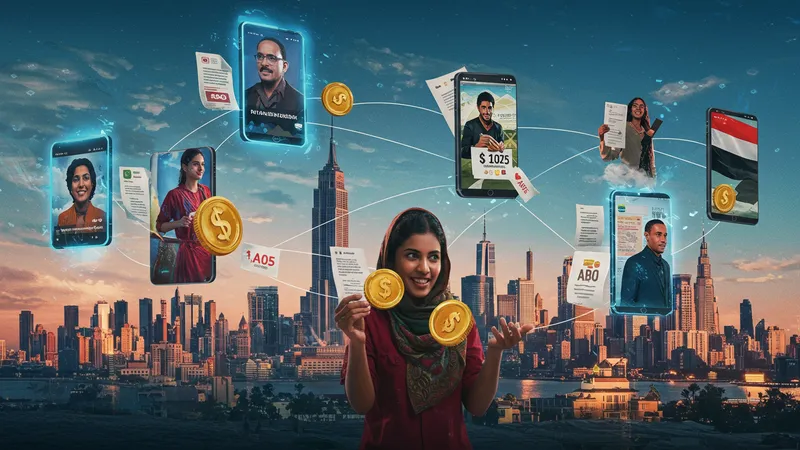Did you know that by 2025, personal loans in Egypt and the USA could completely transform your financial landscape? Experts say that loan structures are evolving fast, and you might be missing out on groundbreaking options.
This is more crucial now than ever as both countries are experiencing unprecedented financial shifts. With inflation rates climbing and economic policies changing, understanding these loan options could be your ticket to financial security.

You might assume that a personal loan is just a chunk of borrowed money you have to repay, right? Well, what if I told you that both Egyptian and American loans have hidden layers that could work either for or against you? In Egypt, loans are often tied to cultural and social dynamics, offering community-driven benefits that are unheard of in most American financial models.
In contrast, the U.S. has developed technological integration in their financial systems at a rapid pace. Imagine applying for loans via AI advisors, providing instant approvals and tailored financial strategies! But that's not even the wildest part...
And here's where it gets even more intriguing: 2025 is predicted to be a pivotal year for diving into personal loan options in these nations due to impending policy changes. It might sound like you're about to read a dry economic report, but what happens next shocked even the experts...
When you think about loans, the first thing that comes to mind might not be culture. Yet, in Egypt, cultural nuance plays an unexpected role. In 2025, micro-loans are expected to include cultural incentives such as lower interest rates for borrowers who support local artisans. Imagine a loan that not only fulfills financial needs but also enriches cultural heritage. This unique feature makes Egyptian loans an intriguing choice for both residents and expatriates exploring investment opportunities.

However, there’s more nuance than meets the eye. Religious considerations also influence financial decisions in Egypt. Islamic finance, which complies with Sharia law, prohibits riba (interest) and encourages profit-sharing methods instead. This means that financing terms often look vastly different from U.S. models and could result in surprisingly beneficial terms for borrowers seeking zero-interest options. But wait, there’s a twist...
Some lenders are experimenting with hybrid models, merging traditional and modern elements. These models allow more flexibility and cater to a broader audience, encouraging, for instance, young entrepreneurs to secure loans tailored to their unique needs. With these leaps in innovation, Egyptian finance is carving out a niche that major global banks are beginning to notice. But the real surprise lies in one more edge...
The social impact of these loans can’t be underestimated. In 2025, expect loans that directly contribute to social welfare projects as part of their structure in Egypt. This radical approach means that by taking a loan, you could simultaneously be part of something much greater, supporting initiatives that uplift financial health across communities. What comes next might just change your perception forever...
The U.S. is experiencing a technological renaissance when it comes to personal loans. By 2025, smart contracts and blockchain technology are set to redefine loan agreements, making the entire process more transparent and secure. It sounds like science fiction, but in reality, these elements are already being tested by major U.S. banks. Imagine the potential impact on fraud prevention and trust-building between lenders and borrowers.

A seamless digital interface might sound like a dream, but in 2025, AI-driven loan approvals will be the norm. These intelligent systems can analyze a wealth of data points, including spending habits, income trends, and even emotional cues, to offer personalized loan proposals within minutes. But here’s the kicker—AI can also offer credit coaching, helping you optimize your financial health alongside your loan acquisition. Yet, there’s a caveat...
A sudden pivot in policy could lead to regulatory challenges. U.S. lawmakers are scrambling to keep up with the rapid evolution of technology in the financial sector. This sometimes results in a lag between innovation and regulation, creating a potentially volatile environment. But don't fret; the advancement of technology promises another layer of financial security that might surprise you...
By 2025, virtual reality (VR) banking could become mainstream, potentially reducing physical bank visits and encouraging more personalized customer experiences. Picture having a real-time conversation with your bank advisor in a virtual setting, measuring financial progress through interactive simulations. The next part dives deep into the costs and benefits, and it's a game-changer...
If you're looking into personal loans for 2025, a vital aspect to consider is interest rates, and here’s where things get eye-opening. In Egypt, for example, interest rates have traditionally been influenced by government policy and the central bank’s regulations. By 2025, these rates are expected to create a favorable borrowing landscape for consumers amidst economic reforms aimed at stabilizing and stimulating the economy. But there’s a lesser-known aspect to consider...

On the U.S. side, interest rates are historically variable and can be influenced by Federal Reserve policies and inflation trends. By 2025, the forecasted adjustments in national economic policy could either skyrocket or drastically lower these rates, affecting consumers’ borrowing power. This presents a conundrum for potential borrowers who may face unpredictability in loan costs. Yet, surprisingly, this isn’t the end of the story...
You might find that the true cost of a loan depends as much on the hidden fees as on the advertised interest rate. In Egypt, for example, customers often encounter fees for administration and insurance, which can subtly inflate repayment totals. Meanwhile, in the U.S., late payment fees and variable interest terms can still catch borrowers off-guard. Nevertheless, there’s an innovative solution to consider...
2025 will usher in financial products that spotlight simplicity, reducing the maze of additional charges to appeal to a transparency-craving public. This shift is expected on both sides of the Atlantic, favoring consumers who value clarity over complexity. The next insight is a peek into the demographic changes shaping these financial landscapes...
Understanding who's buying into loans and why is integral but often overlooked. In Egypt, the youth demographic is becoming a powerful force in driving financial products, with loan packages tailored for entrepreneurial ventures. By 2025, loans with low-entry barriers designed to foster startup growth amongst young Egyptians are expected to flourish. There’s more than meets the eye with such focused demographics...

In contrast, the U.S. sees a growing segment of loans targeted at older adults heading into retirement or supporting second careers. These loans often come with unique terms aimed at providing financial stability, like reverse mortgage loans. But as the demand for these loans increases, another unprecedented trend emerges that could shape future offerings...
Transnational borrowing is set to rise in the future, as cultural ties lead to cross-border financial collaborations. Imagine an Egyptian-American population leveraging financial options across both countries, benefiting from the best interest rates, or cultural incentives. This novel form of lending could revolutionize financial opportunities for dual citizens and expatriates alike, saving costs and maximizing benefits.
Digging deeper, 2025 might witness a surge in specialized loans for particular sectors, such as green loans for environmentally focused projects. Recognizing the link between sustainable development and finance is crucial, but it’s only a part of the broader picture shaping up next...
2025 ushers in an era where accessibility is king in the financial world. In Egypt, micro-financing initiatives are expected to thrive, targeting underserved communities and providing cushion loans through accessible online platforms. This democratization of finance breaks the chains holding back potential borrowers without traditional credit histories. Yet, that’s only scratching the surface of what’s to come...

Across the U.S., inclusivity in financial services is more than just a trend; it’s becoming a necessity. With an increasing number of fintech startups launching in 2025, borrowers can expect to access loan products that are more suited to individual needs through tailor-made solutions. These startups are stripping back the smoke and mirrors of traditional loan practices to reveal transparency like never before. But there’s another layer to explore...
Digital bank branches are beginning to embrace community-driven solutions where clients can suggest loan terms or collaborate with other borrowers for better rates. Could we be on the cusp of a financial co-op model that changes the landscape forever? This engagement is turning the script, encouraging a sense of community accountability. But if you think that’s the last innovation, think again...
The rise of collaborative platforms where lenders pitch to the borrower, akin to reverse auctions, might sound like a fantasy, but it’s closer to realization than you'd expect. This reversing of roles promises borrowers greater bargaining power and could redefine negotiation dynamics. Next, we delve into the public sentiment driving these tectonic shifts...
Public sentiment towards borrowing is evolving more rapidly than policymakers can adapt to. In Egypt, there’s a burgeoning trend of skepticism towards risk, nudging the market towards safer, more secure financial products by 2025. The populace is favoring loans backed by strong governmental or religious frameworks providing a trustworthy veneer to the unstable waters of finance. However, even such confidence has its limits...

The U.S. is witnessing a counter-movement of borrowers seeking autonomy and empowerment through education and digital access. The focus on financial literacy is reshaping the landscape, with borrowers demanding transparency and no-nonsense loan terms. It’s a revolution from below, building a generation of financially savvy individuals exposing the hidden costs and pitfalls of traditional loans. Yet, there’s another wind blowing...
Beyond borders, cultural differences in trust are influencing borrowing behaviors. While some fear the invasiveness of technological integration, others embrace it as the future of financial transactions. This dichotomy is creating a split in borrower expectations globally. But even as these trends take hold, another phenomenon is shaking things up...
2025 could be the era of borrower-first platforms, emphasizing empowerment. These platforms are not only educating but also organizing communities around financial well-being. Imagine a global network where your financial profile continuously earns trust points. This could transform how loans are approved and managed. Up next, the unexpected will challenge all initial assumptions...
Regulatory oversight can be a double-edged sword in the world of loans. In Egypt, strict regulations can both protect and hinder consumers. In seeking a surplus of caution, policies at times restrict flexibility, resulting in bottlenecks for potential borrowers who crave innovation and adaptability in their loan products. This tug-of-war invites a deeper examination...

2025 sees the U.S. financial landscape battling intense regulation debates, where rules like Dodd-Frank are periodically scrutinized and reimagined. While regulations are put in place with borrowers' safety in mind, they often constrain financial innovations that could benefit end-users. This delicate balance remains an ongoing challenge, but a fresh perspective offers new solutions...
The future of regulations might not be about loosening or tightening them, but rather smart regulations that evolve with technology. Imagine real-time compliance monitoring and AI-driven legal interpretations ensuring that financial institutions adapt to changing laws seamlessly. This could eliminate bureaucratic drag and speed up loan processes, but that’s not the full picture...
The potential for cross-border regulatory synergies could unify borrowing standards across nations. Some experts predict a future where a person could apply for a loan in one country and adhere to international financial standards seamlessly—a concept that felt far-fetched but is now hovering on the edge of possibility. The next development invites an unforeseen synergy...
Lenders are increasingly realizing the power of education in transforming the borrowing landscape. In Egypt, specialized programs aimed at deconstructing financial jargon are illuminating potential borrowers on complex loan dynamics, empowering citizens to make educated decisions by 2025. It’s the sacred marriage of knowledge and accessibility, but there’s more to it...
In the U.S., financial literacy initiatives are being integrated into academic curriculums nationwide. These programs aim to produce financially literate generations capable of deploying strategic insights for personal financial growth. By 2025, these educational endeavors might translate into smarter borrowing decisions and better financial outcomes for graduates. However, that’s just the visible edge...
What if knowledge could alleviate loan default rates? Preliminary studies hint that educated borrowers are less likely to fall into debt traps, influencing loan structure and risk assessment models globally. This paradigm shift also calls for innovative education programs that extend beyond mere awareness. And yet, there’s another chapter unfolding...
Cross-country education exchanges are expected to bloom, where students from Egypt and the U.S. can gain international perspectives on finance. This might pave the way for shared learning, insights, and potentially groundbreaking financial products that cater to their mutual needs. The ensuing pages tackle yet another dramatic evolution...
2025 promises an ethical quagmire as AI steps boldly into the financial sector, particularly in loan processing. In Egypt, where human-centric traditions often dominate, the ethical implications of AI-driven decision-making provoke robust debate. On the surface, artificial intelligence promises speed and efficiency, but what if biases lurk beneath the algorithms?

The U.S. is no stranger to these ethical dilemmas. Recognizing AI's potential for both success and missteps, constant vigilance and oversight are critical. In the emotional world of money lending, it's essential to comprehend the ethical line between technology assistance and human equity. Yet the ethical horizon reaches further still...
Let’s consider the question of privacy. As AI becomes more deeply integrated, personal data security leaps into the spotlight. By 2025, granular measures will be required to protect borrower information. Financial institutions face the tightrope of employing AI tools while maintaining individual confidentiality. Still, this only brushes the surface of the issue...
Global cooperation and norm-setting might come to define the solution. A set of universal ethical guidelines—crafted and updated regularly—could help navigate this brave new world. Imagine AI algorithms that are standardized and regulated to ensure fair play. The potential is as tantalizing as it is daunting. In what's ahead, financial history takes a critical turn...
Peer-to-peer (P2P) lending platforms are set to revolutionize how loans operate in 2025. In Egypt, these platforms democratize the lending landscape, enabling individuals to borrow directly from others without traditional financial gatekeepers. It's financial empowerment at its finest, but the real magic happens when partnerships form across borders...

In the U.S., the P2P lending phenomena are poised for explosive growth. By eliminating intermediaries, these platforms provide loans with minimal fees, offering competitive rates that appeal to tech-savvy younger generations. The diffusion of this model may challenge conventional banks and reshape the borrowing terrain. But dive a little deeper, and you'll find another story...
Risk and trust become the keystones of P2P lending. 2025 might see blockchain technology integrated within these platforms, ensuring secure, transparent transactions while maintaining a high level of trust between borrowers and lenders. This element could catapult P2P lending into the mainstream financial consciousness. Yet, what more might be discovered from this shift...
As these dynamics evolve, alliances between regulatory agencies around the world may establish structured frameworks, fostering cooperation and standardization in P2P lending practices. Imagine a seamless financial ecosystem that transcends national boundaries, where global citizens access loans freely—an aspiration tantalizingly within reach. Expect an esplosive finish as we wrap up this transformative journey...
2025 will usher in an era where loan approvals become instantaneous, thanks to the rapid evolution of AI technologies. In Egypt, instant approvals could revolutionize personal finance by offering quicker access to funds for urgent needs, but not everyone will welcome these changes with open arms...

The same holds true in the United States. Real-time data analysis enables faster decision-making, but questions of accuracy and reliability persist. Lenders are racing against time to ensure that speedy approvals don't sidestep the meticulousness that protects both parties in the borrowing process. But dig deeper, and another complexity arises...
With AI’s presence, the critical component will be balancing speed with safety. By 2025, expect hybrid models that combine AI efficiency with human oversight to ensure robust, fair, and transparent decisions. It might just redefine the entire loan approval mechanism. Yet, there's an even larger picture at play...
Imagine seamless integration into a global system that values agility and accountability. Will the face of finance be forever altered by these colossal developments? These endgame scenarios hint at a reshaped fiscal environment where innovation meets opportunity. It’s a dramatic finale, but what it foreshadows is entirely on a different plane...
As the curtain falls on this exploration of finance's future, we find ourselves with more questions than answers—but one thing is clear: the personal loan landscape is on the brink of a monumental transformation. As 2025 approaches, technology, culture, and innovation promise to redefine conventional borrowing norms, blending tradition with modernity in ways that seemed impossible just years ago.
The journey we’ve traveled reveals myriad opportunities and challenges. If you’re poised on the cusp of this financial evolution, consider sharing these insights with friends and networks. Who knows, the knowledge could prove pivotal, sparking conversations that help shape a sustainable future for all. So bookmark this page, join the dialogue, and let's explore the world of finance together!